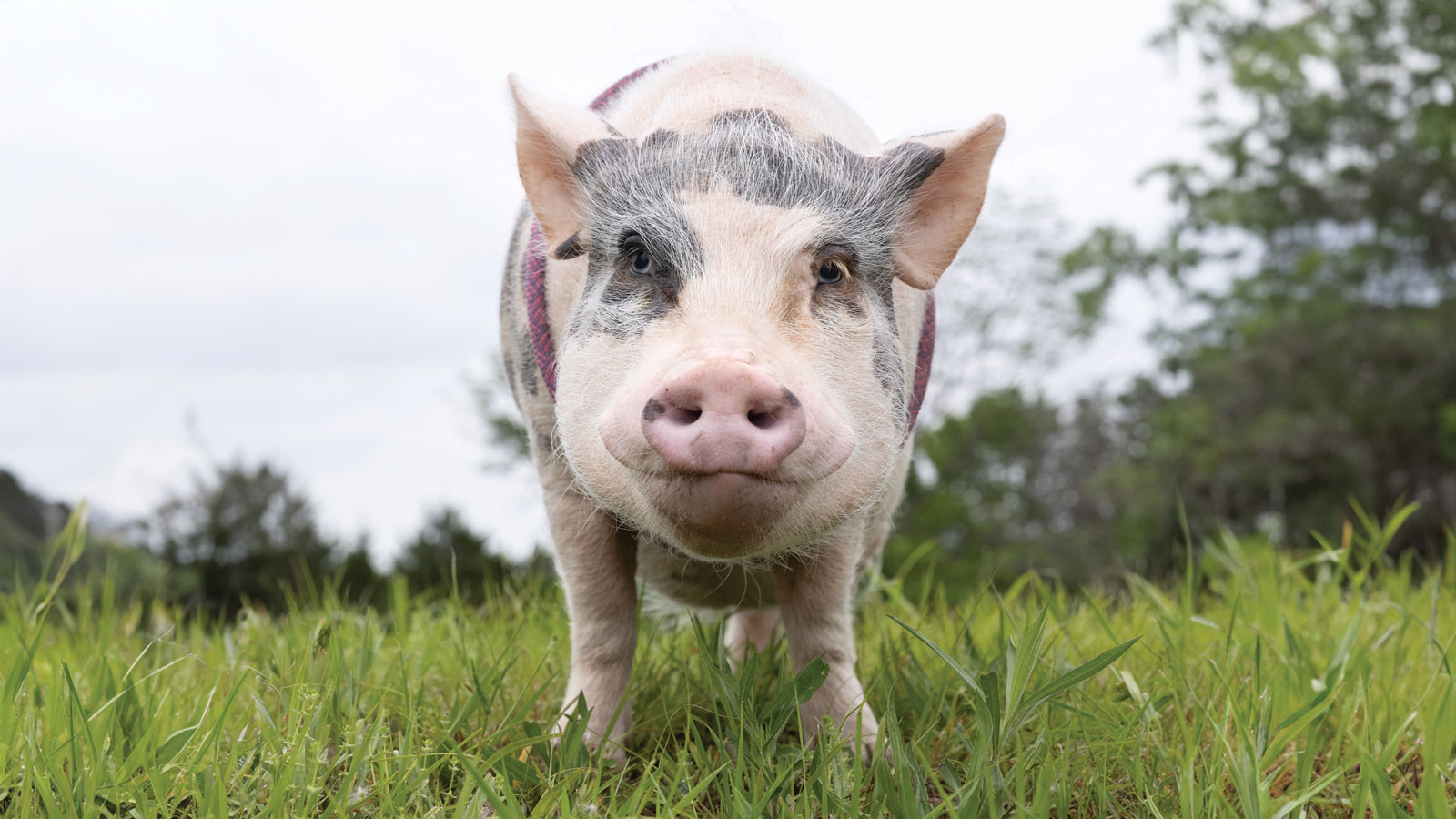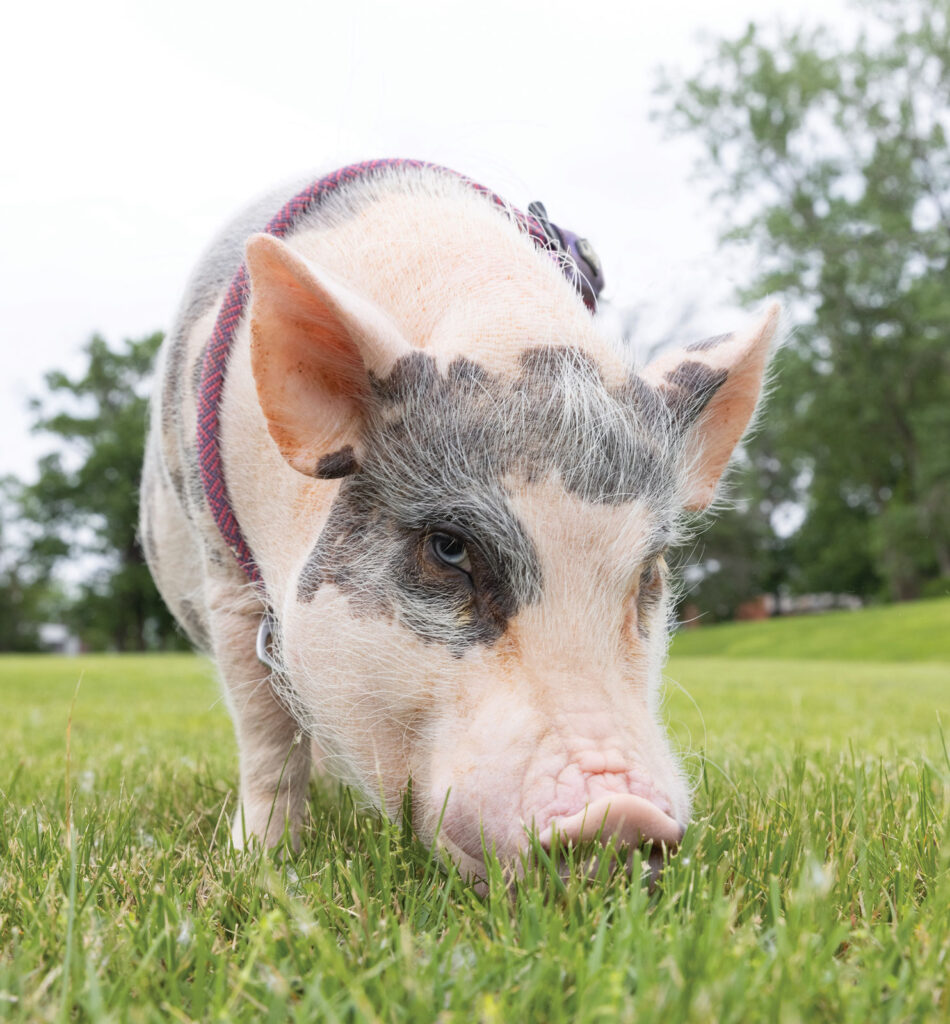Pig Tales
- Photos by Anthony Jinson.
- "Pig Tales" originally appeared in the June 2024 "Animal" issue of COMO Magazine.

Pet porker Truffles lives ‘in the lap of luxury.’
Picture yourself on a game show like Family Feud. The host’s prompt echoes, “Name a common household pet,” and you have seconds to respond. It seems easy enough, right? Your mind would likely conjure images of a cat or dog. Depending on who you are, you might also think of a fish, bird, hamster, or rabbit. However, if your initial response to the prompt was “pig,” you’d probably find yourself out of luck.
While domestic pigs may not enjoy the same level of popularity as traditional housecats or dogs, they’ve surprisingly gained traction in the United States over the years, particularly during the 1970s — though more as a fashion accessory than anything — and in the ‘90s and 2000s. Advertised as teacup pigs or mini pigs with the promise of perpetual smallness (myth), they often captured the interest of families with children and younger individuals.
Truffles the Pig
Maggie Hynes, a Stephens College alumna, hadn’t necessarily planned to adopt a pet pig. The emergence of mini pigs happened to coincide with her sophomore year of college and because Stephens is a pet-friendly campus, the college did not hesitate to accommodate her when she proposed the idea of adopting one.
“There was this mini pig farm in Florida,” she recalls. “There were like 300 other pigs running around and Truffles was the only little white pig in a litter who just looked like she wanted to be picked up.”
Truffles, a mini pig with a touch of the Juliana breed, was around eight pounds and the size of a Venti Starbucks drink when Maggie adopted her.
Fast-forward to eleven years later, Truffles has long been gone from the dorms and now lives with Maggie, her wife, Jessi (also a Stephens alumna), and their cat, Puddle — and their porcine pet sure does keep their lives entertaining.

5 Fun Facts About Truffles
- Truffles travels well in the car and has taken several trips to Florida.
- Truffles receives yearly vaccinations and check-ups. She also has a high tolerance for sedative drugs.
- Though Truffles knows many complex tricks, she can’t sit.
- Truffles was the first pet pig at Stephens College and has been featured in their brochures.
- Truffles gets the “zoomies” — just like cats and dogs.
Not Your Average Pet
In some ways, Truffles is similar to cats and dogs. She knows tricks, uses a litter box, and loves to cuddle with Maggie and Jessi in bed.
On the other hand, Truffles is more intelligent than cats and dogs; in fact, pigs are believed to be as smart as three-year-old children. Truffles knows over a hundred tricks, including identifying specific toys, recognizing colors, following hand and voice commands, and playing the bongos. If there’s any trick that Maggie and Jessi think of, they can usually teach Truffles how to do it by the end of the day.
“When I was in college, Truffles learned how to open my mini fridge, just from watching my morning routine,” Maggie says. “I suddenly realized she can get into the fridge and pull things out, so I had to move it.”
Jessi laughs, “We’re a childless home that’s baby-protected and baby-gated. If you were going to compare [having a pig] to any other pets, it’s like having a dog and a baby at the same time.”
While cats and dogs often get into trouble due to their animal instincts, Truffles likes to be naughty to get attention — a behavior the couple calls “being mischievous with a purpose.” For example, she isn’t allowed in the bathroom, but she’ll go in, close the door, and wait for Maggie or Jessi to find her. Truffles also pretends to rummage in the recycle bin to see if anyone will notice and catch her in the act.
In general, though, Truffles lives a relaxed life. She isn’t an early bird, so after Jessi feeds her at 7 a.m., she goes back to sleep until lunchtime. Afterward, Truffles enjoys playing with her snuffle pad and toys while Maggie prepares for the day. Truffles also spends plenty of time outdoors, eating grass, digging in hay, and lying on her pillow.
“She kind of lives in the lap of luxury,” Jessi says. “She gets dinner, which consists of mini pig food and fruits and vegetables … and then if we’re watching TV or playing video games, she might be upstairs with us, hanging out. She even has a heating blanket.”
Pig Parenthood
As with any pet, it’s essential to do your research before adopting. There are substantial responsibilities when it comes to owning a mini pig — and they have different needs than more traditional pets, too.
Many prospective mini pig owners underestimate the amount of effort involved in caring for their pet, persuaded by how cute and small the young pigs are and how easy the caring process is in the early days. It’s important to understand that caring for a mini pig entails more than just their initial appeal suggests.
“It takes a lot of extra time and preparation to care for her,” Jessi explains. “We kind of suit our whole lives to Truffles. We have a car ramp so she can get in and out, and I built a fifteen-foot ramp on our stairs to take her outside because she can’t go down the stairs. It’s just ever evolving.”
“And you need to give pigs a lot of attention,” Maggie adds. “Because they are so smart, they can get very bored. My whole day revolves around doing things for Truffles.”
Mini pigs can become destructive when they are bored, which may involve eating drywall and pulling up carpets. Because pigs are as intelligent as toddlers, they can’t be left alone for long periods as a cat or dog could be. Pigs are also emotional creatures that require regular one-on-one time with their owners.
In contrast, providing pigs with their own space to retreat is essential, and it should be respected. Truffles, for example, has her own room, equipped with a ten-foot by five-foot cage for sleeping, a litter box, and her food bowl. Her owners only enter her room when necessary for cleaning.
Diet and exercise are also critical to caring for mini pigs properly. Without proper exercise and feeding, mini pigs can gain excessive weight, leading to health complications such as joint and mobility issues, and a shorter lifespan. To prevent this, Truffles is frequently walked on a leash and fed according to her veterinarian’s advice, with added supplements.
“It is a lot of work,” Maggie says, “but I do enjoy it.” When asked if she would do it all over again, Jessi jumped in to answer, chuckling: “She [Maggie] just asked me for another pig yesterday.”








